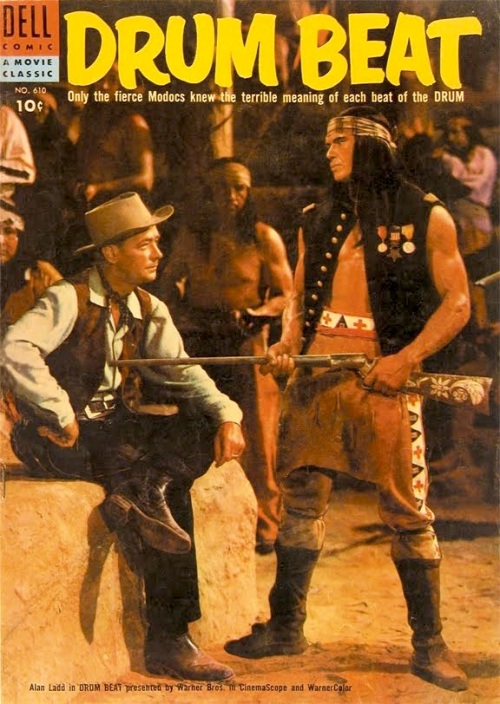
Written and Directed by Delmer Daves
Director Of Photography: J. Peverell Marley, ASC
Film Editor: Clarence Kolster
Music by Victor Young
CAST: Alan Ladd (Johnny Mckay), Audrey Dalton (Nancy Meek), Marisa Pavan (Toby), Robert Keith (Bill Satterwhite), Charles Bronson (Captain Jack)
Not long after Shane (1953), Alan Ladd left Paramount, the studio that made him a star, and launched his independent company, Jaguar. Their first film was Drum Beat (1954). Based on the 1873 Modoc War, Ladd plays an Indian fighter recruited by President Grant to find a way to peace with the Modoc. Turns out the tribe wants peace, but a chief named Captain Jack (Charles Bronson) and his band of renegades are lousing things up. Repeated attempts for a peaceful resolution are unsuccessful, and we get a very exciting last couple of reels.
Though I’m not a big Alan Ladd fan, I really liked this one. It wears its “sympathetic treatment of the Indians” thing well, but never forgets that it’s action that puts people in the seats. Boy, a lot of people get shot in this thing.

My job is to protect the wagon train. When somebody shoots at my people, I shoot back.”
— Alan Ladd
Ladd and Daves (and, of course, DP J. Peverell Marley) shot Drum Beat in Warnercolor and the then-new CinemaScope. As was the custom with ‘Scope at the time, they avoided close-ups, went for long takes whenever possible, and gave us lots of gorgeous vistas of Sonora, Arizona, and the Coconino National Forest. Daves always showed off the landscape in his Westerns, making each setting an essential element of the film, and this is one of Drum Beat’s great strengths. If there’s a film that makes better use of the Sonora area, I don’t know what it is.
The cast is a 50s Western fan’s dream: James H. Griffith (as a Civil War veteran who lost a leg at Shilo), Frank Ferguson, Elisha Cook, Jr., Willis Bouchey, Perry Lopez, Anthony Caruso, Denver Pyle and Strother Martin (who I heard was in it, but somehow missed). Of course, Charles Bronson makes quite an impression as Captain Jack in his first film under his new name (it had been Buchinsky, which was considered too Russian-sounding in the HUAC years).
With Drum Beat, Warner Archive gives us a pretty good-looking DVD. The Warnercolor is, well, Warnercolor — but here it looks as good as I’ve ever seen it look. The image is a tad soft at times (varying from shot to shot), some of which we can blame on the early CinemaScope. The audio is excellent; I love the stereo sound of these early Scope pictures, with an actor’s voice following them as they move around within the wide frame. This is a really good film, and a real treat in widescreen and stereo (I’d love to see a Blu-ray turn up someday). Highly recommended.
Alan Ladd and Delmer Daves reunited for The Badlanders (1958), also available from Warner Archive. I haven’t seen it in ages, and I’m really eager to revisit it.
Along with Drum Beat, two more Ladd Westerns came riding into town, thanks to Warner Archive.

The Big Land (1957)
Directed by Gordon Douglas
CAST: Alan Ladd, Virginia Mayo, Edmond O’Brien, Anthony Caruso, Julie Bishop and John Qualen
Ladd’s a cattle man who works to build a town around a railroad hub, which will benefit the local ranchers. Of course, there’s someone who doesn’t want all this to happen.
As a drunk, Edmond O’Brien steals every scene he’s in. He’s terrific. This is WarnerColor again, and it’s not as well-behaved as it is in Drum Beat. Good movie, though, especially if you’re a fan of O’Brien or Virginia Mayo. Gordon Douglas is as dependable as ever.

Guns Of The Timberland (1960)
Directed by Robert D. Webb
CAST: Alan Ladd, Jeanne Crain, Gilbert Roland, Frankie Avalon
This time, Ladd’s a lumberjack who arrives in the Northwest to take out a lot of trees. The townspeople are afraid Ladd’s efforts will cause mudslides and do other environmental harm. Frankie Avalon sings “Gee Whiz Whillikins Golly Gee,” which Bugs Bunny used to sing in the bumpers to The Bugs Bunny Show on Saturday mornings. This tune is just one of the things that put Guns Of The Timberland in that goofy time period that a lot of series Westerns exist in, where Old and New West, cars and buckboards peacefully coexist.
Jeanne Crain is beautiful, Gilbert Roland is as cool as ever, and Lyle Bettger actually gets to be a good guy for once. The Technicolor makes it to DVD looking like a million bucks, while alcohol has Ladd looking just terrible.
Read Full Post »

















